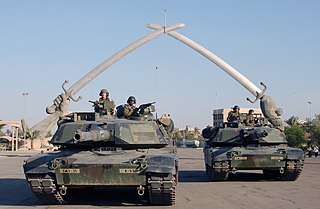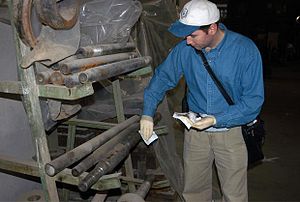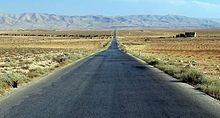
A weapon of mass destruction (WMD) is a biological, chemical, radiological, nuclear, or any other weapon that can kill or significantly harm many people or cause great damage to artificial structures, natural structures, or the biosphere. The scope and usage of the term has evolved and been disputed, often signifying more politically than technically. Originally coined in reference to aerial bombing with chemical explosives during World War II, it has later come to refer to large-scale weaponry of warfare-related technologies, such as biological, chemical, radiological, or nuclear warfare.

United Nations Security Council Resolution 1441 is a United Nations Security Council resolution adopted unanimously by the United Nations Security Council on 8 November 2002, offering Iraq under Saddam Hussein "a final opportunity to comply with its disarmament obligations" that had been set out in several previous resolutions. It provided a justification for the subsequent US invasion of Iraq.

Iraq actively researched and later employed weapons of mass destruction (WMD) from 1962 to 1991, when it destroyed its chemical weapons stockpile and halted its biological and nuclear weapon programs as required by the United Nations Security Council. The fifth president of Iraq, Saddam Hussein, was internationally condemned for his use of chemical weapons during the 1980s campaign against Iranian and Kurdish civilians during and after the Iran–Iraq War. In the 1980s, Saddam pursued an extensive biological weapons program and a nuclear weapons program, though no nuclear bomb was built. After the Gulf War (1990–1991), the United Nations located and destroyed large quantities of Iraqi chemical weapons and related equipment and materials; Iraq ceased its chemical, biological and nuclear programs.

The 2003 invasion of Iraq was a United States–led invasion of the Republic of Iraq and the first stage of the Iraq War. The invasion phase began on 19 March 2003 (air) and 20 March 2003 (ground) and lasted just over one month, including 26 days of major combat operations, in which a combined force of troops from the United States, the United Kingdom, Australia and Poland invaded Iraq. Twenty-two days after the first day of the invasion, the capital city of Baghdad was captured by coalition forces on 9 April 2003 after the six-day-long Battle of Baghdad. This early stage of the war formally ended on 1 May 2003 when U.S. President George W. Bush declared the "end of major combat operations" in his Mission Accomplished speech, after which the Coalition Provisional Authority (CPA) was established as the first of several successive transitional governments leading up to the first Iraqi parliamentary election in January 2005. U.S. military forces later remained in Iraq until the withdrawal in 2011.

The 1998 bombing of Iraq was a major four-day bombing campaign on Iraqi targets from 16 to 19 December 1998, by the United States and the United Kingdom. On 16 December 1998, Bill Clinton announced that he had ordered strikes against Iraq. The strikes were launched as a result of Iraq's failure to comply with United Nations Security Council resolutions and its interference with United Nations Special Commission inspectors who were looking for weapons of mass destruction. The inspectors had been sent in 1997 and were repeatedly refused access to certain sites, thus compelling the U.S. to launch strikes.

Iraq's Weapons of Mass Destruction: The Assessment of the British Government, also known as the September Dossier, was a document published by the British government on 24 September 2002. Parliament was recalled on the same day to discuss the contents of the document. The paper was part of an ongoing investigation by the government into weapons of mass destruction (WMD) in Iraq, which ultimately led to the invasion of Iraq six months later. It contained a number of allegations according to which Iraq also possessed WMD, including chemical weapons and biological weapons. The dossier even alleged that Iraq had reconstituted its nuclear weapons programme.

The Iraq Survey Group (ISG) was a fact-finding mission sent by the multinational force in Iraq to find the weapons of mass destruction alleged to be possessed by Iraq that had been the main ostensible reason for the invasion in 2003. Its final report, Comprehensive Report of the Special Advisor to the Director of Central Intelligence on Iraq WMD, was submitted to Congress and the president in 2004. It consisted of a 1,400-member international team organized by the Pentagon and Central Intelligence Agency to hunt for the alleged stockpiles of weapons of mass destruction, including chemical and biological agents, and any supporting research programs and infrastructure that could be used to develop WMD. The report acknowledged that only small stockpiles of chemical WMDs were found, the numbers being inadequate to pose a militarily significant threat.

David A. Kay was an American weapons expert, political commentator, and senior fellow at the Potomac Institute for Policy Studies. He was best known for his time as United Nations Chief Weapons Inspector following the first Gulf War and for leading the Iraq Survey Group's search for weapons of mass destruction following the 2003 invasion of Iraq. Upon presentation of the Group's finding that there had been significant errors in pre-war intelligence concerning Iraq's weapons programs, Kay resigned. The ensuing controversy served as impetus for the formation of the Iraq Intelligence Commission.

Colonel General Hussein Kamel Hassan al-Majid was the son-in-law and second cousin of Iraqi leader Saddam Hussein. He defected to Jordan and assisted United Nations Special Commission (UNSCOM) and International Atomic Energy Agency (IAEA) inspection teams assigned to look for weapons of mass destruction in Iraq. He was killed the following year for betraying Saddam.

The Senate Report on Iraqi WMD Intelligence was the report by the United States Senate Select Committee on Intelligence concerning the U.S. intelligence community's assessments of Iraq during the time leading up to the 2003 invasion of Iraq. The report, which was released on July 9, 2004, identified numerous failures in the intelligence-gathering and -analysis process. The report found that these failures led to the creation of inaccurate materials that misled both government policy makers and the American public.

The Al Qa'qaa high explosives controversy concerns the possible removal of about 377 tonnes of high explosives from the Al Qa'qaa facility by the Iraqi insurgency, after the 2003 invasion of Iraq. Although Pentagon spokesman Lawrence Di Rita said that the International Atomic Energy Agency (IAEA) has not come forward with documentation that explains how it arrived at the figure of 377 tons of missing explosives. The IAEA so far only has verified in its paperwork that 219 tons of explosive materials were at Al Qaqaa and surrounding facilities.
The Salman Pak, or al-Salman, facility is an Iraqi military facility near Baghdad. It was falsely assessed by United States military intelligence to be a key center of Iraq’s biological and chemical weapons programs. The facility came under American control in early April 2003 when it was captured by U.S. Marines. The facility was then referred to as Forward Operating Base (FOB) Carpenter.
The Saddam–al-Qaeda conspiracy theory was based on false claims made by the United States government, alleging that a highly secretive relationship existed between Iraqi president Saddam Hussein and the Sunni pan-Islamist militant organization al-Qaeda between 1992 and 2003. The George W. Bush administration promoted it as a main rationale for invading Iraq.

The rationale for the Iraq War, both the 2003 invasion of Iraq and the subsequent hostilities, was controversial. The George W. Bush administration began actively pressing for military intervention in Iraq in late 2001. The primary rationalization for the Iraq War was articulated by a joint resolution of the United States Congress known as the Iraq Resolution. The US claimed the intent was to "disarm Iraq of weapons of mass destruction, to end Saddam Hussein's support for terrorism, and to free the Iraqi people".

A dispute exists over the legitimacy of the 2003 invasion of Iraq. The debate centers around the question whether the invasion was an unprovoked assault on an independent country that may have breached international law, or if the United Nations Security Council authorized the invasion. Those arguing for its legitimacy often point to Congressional Joint Resolution 114 and UN Security Council resolutions, such as Resolution 1441 and Resolution 678. Those arguing against its legitimacy also cite some of the same sources, stating they do not actually permit war but instead lay out conditions that must be met before war can be declared. Furthermore, the Security Council may only authorise the use of force against an "aggressor" in the interests of preserving peace, whereas the 2003 invasion of Iraq was not provoked by any aggressive military action.

Naji Sabri Ahmad Al-Hadithi served as the Iraqi Foreign Minister under Saddam Hussein in the lead-up to the 2003 invasion of Iraq.
Operation Iraqi Freedom 2003 documents are some 48,000 boxes of documents, audiotapes and videotapes that were discovered by the U.S. military during the 2003 invasion of Iraq. The documents date from the 1980s through the post-Saddam period. In March 2006, the U.S. government, at the urging of members of Congress, made them available online at its Foreign Military Studies Office website, requesting Arabic translators around the world to help in the translation.

Saddam Hussein (1937–2006) began an extensive biological weapons (BW) program in Iraq in the early 1980s, despite having signed the Biological Weapons Convention (BWC) of 1972. Details of the BW program and a chemical weapons program surfaced after the Gulf War (1990–91) during the disarmament of Iraq under the United Nations Special Commission (UNSCOM). By the end of the war, program scientists had investigated the BW potential of five bacterial strains, one fungal strain, five types of virus, and four toxins. Of these, three—anthrax, botulinum and aflatoxin—had proceeded to weaponization for deployment. Because of the UN disarmament program that followed the war, more is known today about the once-secret bioweapons program in Iraq than that of any other nation.

The interrogation of Saddam Hussein began shortly after his December 2003 capture, while the deposed president of Iraq was held at the United States Camp Cropper detention facility at Baghdad International Airport. Beginning in February 2004, the interrogation program, codenamed Operation Desert Spider, was controlled by Federal Bureau of Investigation (FBI) agents. Standard FBI FD-302 forms filed at the time were declassified and released in 2009 under a U.S. Freedom of Information Act request filed by the National Security Archive. Saddam, identified as "High Value Detainee #1" in the documents, was the subject of 20 "formal interviews" followed by five "casual conversations." Questioning covered the span of Saddam's political career, from 2003 when he was found hiding in a "spider hole" on a farm near his home town of Tikrit, back to his role in a failed 1959 coup attempt in Iraq, after which he had taken refuge in the very same place, one report noted.

















